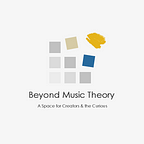The Darkest to Brightest Modes
Now that you have a good idea of how each mode sounds and considering that we are dealing with modes from within the same tonality, it is time see how they relate to each other in terms of feel and color. In terms of balance, when you play the Ionian mode (major scale), it has this natural ascending pull when you start in C and end in B (the leading tone). This is an ascending pull:
On the other hand, when you do the same and stop at F, you might naturally get the urge to play an E. So, this would be a descending pull:
In that sense, the Ionian mode is balanced; the leading tone, or the 7th, resolves up to the tonic and the sub-dominant, or the 4th, resolves down to the mediant (the major third of the C major tonality).
In the diagram below, you can see that the Lydian shows up as being the brightest of the modes. If you do the same procedure, you will probably notice the double pull up from the raised 4th to the 5th and the pull up from the 7th to the 8th degree:
The way that the modes are organized in the diagram has to do with how each note resolves according to its natural pull. For instance, in the Mixolydian mode the half-steps are between the 4th and the 3rd degree and the b7th and the 6th degree, meaning that there is no leading tone pull to the tonic. For this reason, it shows up as the darkest of the major modes suggesting downward resolutions in its melodic flow.
If you consider this, you will be able to navigate from one mode to another within the same tonality according to the relative brightness perception of how each modes. You can also do so by modulating to modes from a different key center, although this will bring in different shades of perception according to the ascending or descending modulation movement made by the harmony and/or the melody. And of course, to the same sense of duality between bright and dark or happy and sad.
On a different note, the Lydian mode can be actually related to Locrian, not just because they are at the far extreme of the spectrum. If you mirror or invert the way Lydian is built (from the top down), you will get the Locrian mode:
The same goes for Ionian / Phrygian and Mixolydian / Aeolian, respectively:
The Dorian mode is the only one in this list that even when you invert the way it’s built is still going to be a Dorian mode — this is called a palindrome, since it maintains the same organizational structure when played forward or backwards:
Keep in mind that any scale, chord or any other musical material, for that matter, can be mirrored or inverted. This presents itself as technique that we will be discussing in future posts.
Slowly we are starting to approach musical concepts with which we will be playing around. For instance, if you have a melodic motif for a hero character in Lydian, then you could consider using the Locrian mode for the villain. As usual, this sensibility has to be developed in a way so that your choices are better informed. When I say that the ‘x’ mode has a brighter sound, this may not be exactly the case to you. So, it is your task to experiment and learn what the different musical materials and their combinations mean to you.
For more, please visit the blog @ https://www.beyondmusictheory.org
